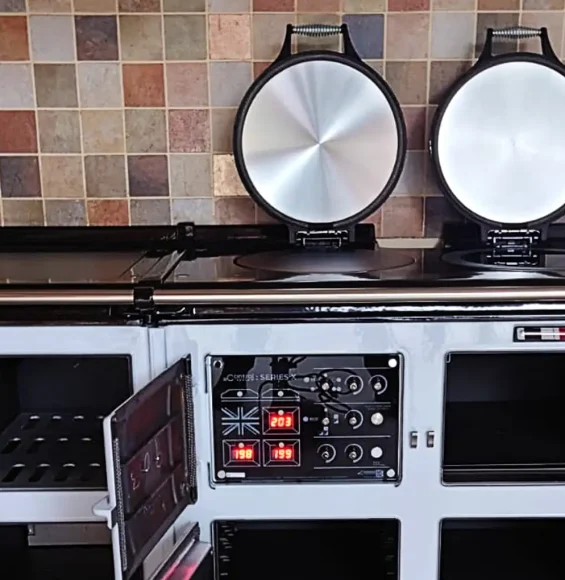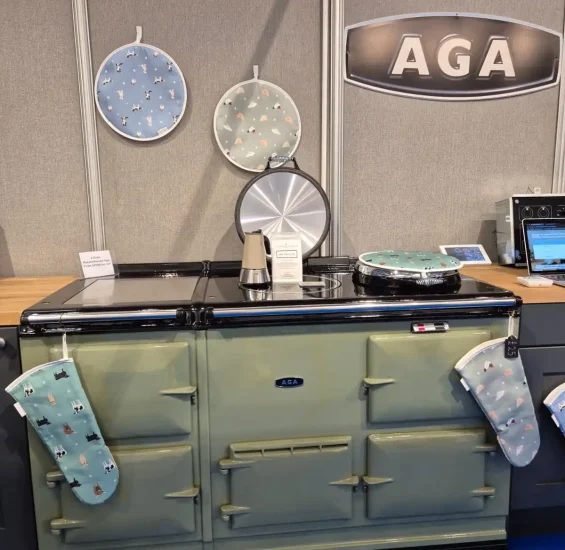What Does It Really Cost to Run an Aga Cooker?
Aga cookers are iconic for their warmth, reliability, and style. But with changing fuel prices and more flexible modern living, most UK homeowners now ask: What are the true running costs of an Aga? The answer depends on fuel type, model, usage pattern, and crucially, whether your Aga uses classic oil/gas, old-style electric, or a modern electric conversion kit.
Below is the latest, most trustworthy breakdown of Aga running costs across all major types – gas, oil, and electric, including up-to-date price examples based on current UK tariffs. We’ve also included detailed charts, comparisons, and real-world examples, plus advice on cutting your bills and upgrading your range cooker for maximum efficiency.
Contents
Summary Table: UK Average Cost of Running an Aga
| Fuel/Model | Weekly Cost | Monthly Cost | Yearly Cost |
|---|---|---|---|
| 2-Oven Gas Aga (Natural Gas) | £25.50 | £110 | £1,326 |
| 4-Oven Gas Aga (Natural Gas) | £31.62 | £137 | £1,645 |
| LPG/Propane Aga | £50–£65 | £216–£281 | £2,600–£3,400 |
| 2-Oven Oil Aga | £24.00 | £104 | £1,248 |
| 4-Oven Oil Aga | £30.60 | £133 | £1,591 |
| 2-Oven Electric Aga (Old, Always-On) | £61.60 | £267 | £3,200 |
| 4-Oven Electric Aga (Old, Always-On) | £75.60 | £328 | £3,936 |
| ElectricKit Classic Conversion | £6–£15 | £26–£65 | £312–£780 |
| ElectricKit Advanced Conversion | £6–£12 | £26–£52 | £312–£624 |
| eControl Series X Conversion | £4–£10 | £17–£43 | £208–£520 |
| eControl Series X-Squared Conversion | £4–£9 | £17–£39 | £208–£468 |
Usage Assumptions & Notes:
All running cost estimates are based on UK average domestic tariffs (Gas: ~6p/kWh, Electricity: 25–28p/kWh, Heating Oil: ~60p/litre) and exclude daily standing charges.
Figures for modern electric conversions assume efficient, controlled use – pre-heating only when required, using slumber/eco settings overnight, and running a limited number of ovens/hotplates at a time.
Actual costs will vary depending on your local tariff, usage patterns, insulation, and cooker model. Heavy continuous use will increase weekly costs beyond the lower ranges shown.
Gas Aga Running Costs
Gas Agas remain popular for their reliability and traditional heat, but what does it cost to run one?
Key Numbers:
- 2-Oven Gas Aga: ~425 kWh/week = £25.50/week (natural gas)
- 4-Oven Gas Aga: ~527 kWh/week = £31.62/week
- LPG (Propane): Up to £50–£65/week due to higher unit cost
Annual Cost Example:
A 2-oven gas Aga, always on, will use about 22,000 kWh of gas a year, costing roughly £1,326/year. Larger 4-oven models can be £1,600+ annually. With LPG (common off-grid), expect to pay double that figure.
Details:
Natural gas is much cheaper per kWh than electricity. However, Agas are “always-on” unless converted, so the bills add up.
Even at lower tariffs, a traditional gas Aga is a serious running cost—often more than your entire central heating.
Some owners now turn the Aga off in summer, or convert to a flexible electric kit (see below).
Gas Saving Tip: If you mainly use your Aga for cooking, consider switching to a modern electric conversion or buying a reconditioned Aga. You’ll benefit from lower running costs, more flexible controls, faster heat-up times, less maintenance, and improved insulation, plus, it’s better for the environment and future-proofs your kitchen.
Oil Aga Running Costs
Oil-fired Agas were a staple in rural homes, but oil costs are unpredictable and running costs can climb quickly.
Key Numbers:
2-Oven Oil Aga: ~40 litres/week = £24.00/week at 60p/litre
4-Oven Oil Aga: ~51 litres/week = £30.60/week
Annual Cost: ~£1,200–£1,600 depending on usage and price swings
Details:
Oil Agas burn kerosene steadily, meaning bills are always ticking up unless the cooker is converted.
The UK price of oil can jump up or down by 10–20% a year, so annual cost can vary a lot.
You’ll need an annual service (at least) to keep oil Agas safe and efficient.
Oil Saving Tip: If you have an oil Aga, you don’t need to replace it to save money. You can convert your existing Aga to a modern electric system during refurbishment. This upgrade removes the need for an oil tank and flue, cuts maintenance, and dramatically lowers your running costs, while keeping the classic Aga look and feel. Learn more on our Aga refurbishment service page.
Electric Aga Running Costs
There’s a huge difference between traditional always-on electric Agas and modern, controllable conversions.
Traditional 13-Amp Electric Agas:
2-Oven: 220 kWh/week = £61.60/week
4-Oven: 270 kWh/week = £75.60/week
Annual cost: £3,000–£4,000 — the most expensive way to run an Aga!
Why so expensive?
Electricity is much pricier than gas or oil per unit.
Old electric Agas are designed to be always-on, so the meter spins day and night.
Modern Electric Agas & Conversions:
Designed for flexible use: only heat the ovens and hotplates when you need them.
Massive savings over old-style Agas.
Electric Aga Conversion Running Costs
Here’s where the real savings are. Modern electric Aga conversion kits offer full control, fast heat-up, and huge reductions in running costs.
Weekly Cost Chart: Electric Aga Conversions
| Conversion Model | Typical Weekly Cost | Annual Cost Estimate |
|---|---|---|
| ElectricKit Classic | £6–£15 | £312–£780 |
| ElectricKit Advanced | £6–£12 | £312–£624 |
| eControl Series X | £4–£10 | £208–£520 |
| eControl Series X-Squared | £4–£9 | £208–£468 |
What these costs mean in real-world energy use (based on 28p/kWh):
| Model | kWh/week range | Approx. kWh/day |
|---|---|---|
| eControl Series X-Squared | 14–32 | 2.0–4.6 |
| eControl Series X | 14–36 | 2.0–5.1 |
| ElectricKit Advanced | 21–43 | 3.1–6.1 |
| ElectricKit Classic | 21–54 | 3.1–7.6 |
How is this possible?
Each oven/hotplate has its own control, so you only heat what you need, when you need it.
With careful use, such as using slumber mode overnight or only keeping one oven on at a time, running costs can drop by 50–80% compared to old-style always-on Agas.
Example:
Using an eControl Series X-Squared conversion for normal family cooking, switching ovens and hotplates on only when needed, can cost as little as £4 per week.
For typical family use, £6–£12/week is common (model-dependent).
In heavier weeks, expect up to £12–£18, especially if running multiple ovens and hotplates for extended periods.
Compare with a traditional electric Aga:
£4–£18/week (conversion) vs. £61.60/week (old always-on electric Aga). That’s £2,000+ per year in savings for many households.
*Figures exclude electricity standing charges and vary with your local unit rate.
Learn more about these solutions on our Electric Aga Conversions page.
Extra Ways to Save with Electric Conversions

Beyond the weekly cost savings, modern conversions bring several hidden advantages:
- Less Heat Loss in Summer – Unlike traditional Agas that run constantly, conversions let you switch off heat sources when not in use, keeping your kitchen cooler and reducing the need for extra ventilation.
- Lower Maintenance Costs – No flue, no oil tank, and fewer moving parts mean fewer repairs and lower annual servicing bills.
- Greener Energy Choices – Pairing your electric Aga with an off-peak tariff or renewable energy source can cut bills even further and reduce your carbon footprint.
- Future-Proofing – With energy prices fluctuating, having the flexibility to adapt your cooking schedule and energy source gives you long-term security.
- Improved Cooking Control – Precise temperature management allows you to run only the ovens or hotplates you need, without sacrificing performance.
Real-World Example: One of our customers in rural Northumberland converted their ageing 2-oven oil Aga to an ElectricKit Advanced Conversion during an Aga refurbishment. Their annual running costs dropped from around £1,900 to approximately £520. They also eliminated the need for oil deliveries, reduced kitchen overheating in summer, and now have the flexibility to switch ovens and hotplates on only when needed, perfect for their busy but energy-conscious household.
Conclusion: Which Aga Is the Cheapest to Run?
If running costs are your main concern, modern electric conversions are the clear winner.
Lowest costs: eControl Series X-Squared – as little as £4–£9/week in light use, typically £6–£12/week, and up to £12–£18/week in heavier weeks.
Close second: eControl Series X – £4–£10/week in light use, typically £6–£12/week, and up to £12–£18/week for heavier cooking.
Still very efficient: ElectricKit Advanced – £6–£12/week typical, up to £14–£18/week in heavier use.
Economical for many households: ElectricKit Classic – £6–£15/week typical, up to £18/week if used intensively.
By comparison, traditional gas, oil, or always-on electric Agas can cost £1,200 to £4,000+ per year to run.

Bottom line: Upgrading your existing Aga to a modern electric system pays for itself quickly, dramatically lowers your bills, and lets you keep all the classic benefits of Aga cooking without the financial strain.
Aga Running Costs FAQs
How much does it cost to run a gas Aga per week?
A typical 2-oven natural gas Aga costs around £25–£26 per week to run, while a 4-oven model is closer to £31–£32 per week. If you’re using LPG (propane), expect to pay almost double due to the higher unit price.
Are oil Agas expensive to run?
Oil Agas are cheaper than old electric Agas but still cost £24–£31 per week at current oil prices (~60p/litre). The exact cost depends on your oven size, insulation, and local fuel price. Costs can vary significantly as oil prices often change by 10–20% a year.
What is the cheapest type of Aga to run?
Modern electric conversions such as the eControl Series X-Squared are the cheapest to run, as little as £4–£9 per week in light use and typically £6–£12/week for most households.
How do electric Aga conversions save money?
Each oven and hotplate has its own control, so you only heat what you need, when you need it. This cuts energy use by 50–80% compared to traditional always-on Agas.
How much electricity does an Aga conversion use?
Depending on the model and usage, modern conversions typically consume 14–54 kWh per week (2–7.6 kWh/day). Light use will be at the lower end, heavy cooking at the upper end.
How quickly will an electric conversion pay for itself?
Most customers recover the cost of a conversion in 2–4 years through reduced fuel bills. In high-use households switching from old electric or oil Agas, the payback can be even faster.
Ready to Lower Your Aga Running Costs?
Whether you want to convert your Aga to an efficient electric system, refurbish your existing model, or buy a reconditioned Aga that works like new, we can help you cut your bills without losing the timeless Aga charm. Request a Callback today and let’s find the perfect solution for your kitchen and your budget.

